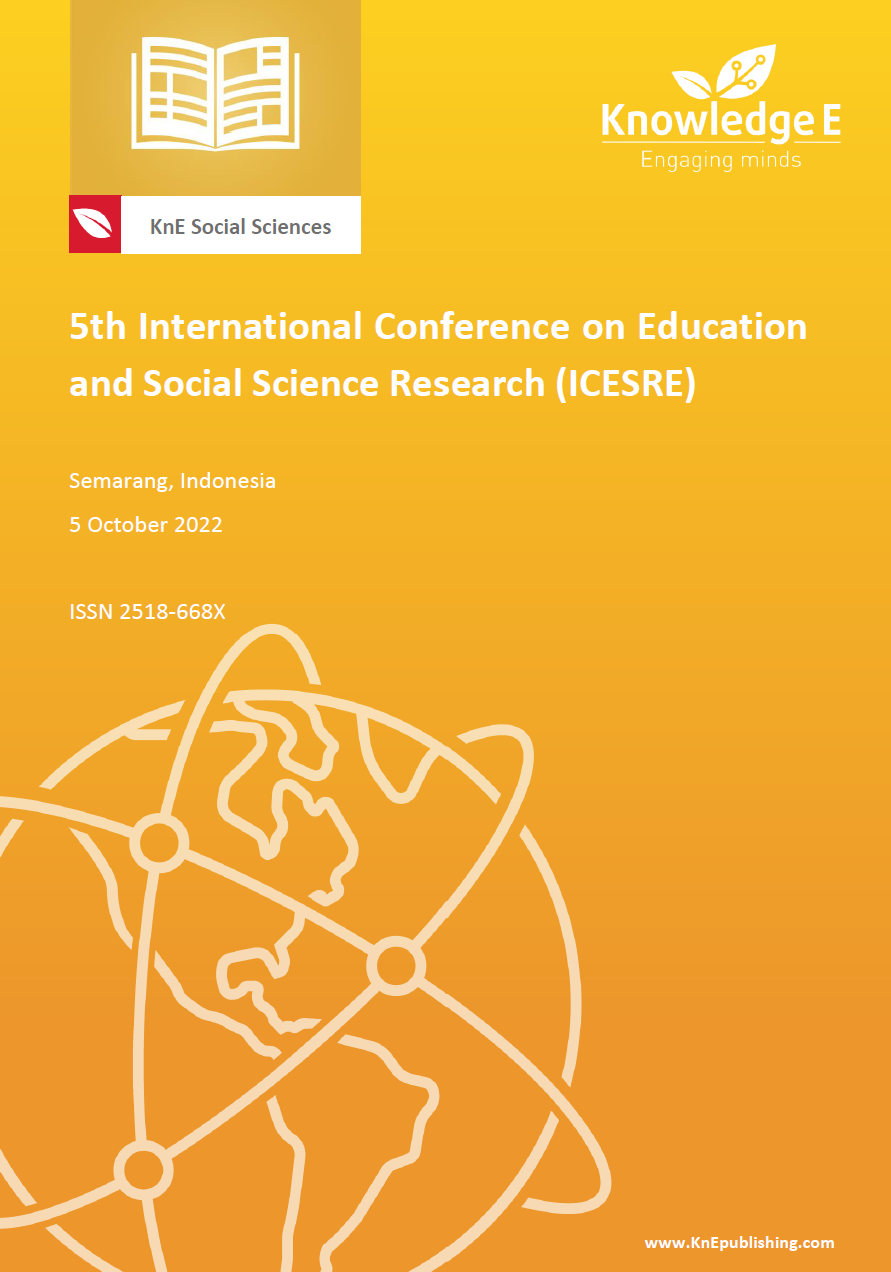Code Switching and Its Implications for Teaching in the English Language in Math Lessons by Early Childhood Education Teachers
DOI:
https://doi.org/10.18502/kss.v7i19.12428Abstract
Interactions between students and between students and teachers are the key to successful learning. This study examines whether code-switching to using English for teaching Math in Semarang’s Early Childhood Education or PAUD programs can improve student interactions. This study investigated how early childhood education teachers implemented code-switching to English instructions for young learners. According to the findings of the study, early childhood educators utilized English, Indonesian, and Javanese interchangeably. The results indicated that the implications of code-switching in school are an approach to acquiring literacy because students can use different languages in a natural and meaningful manner while participating in classroom activities. The study shows that using code-switching in multilingual mathematics classrooms is a beneficial strategy to improve student interactions in classroom activities and is an effective method of transferring knowledge to students. The study further proves that code-switching implications do not result in a learning deficiency.
Keywords: Code-switching, English for Young Learners, English for Math, Instruction
References
[2] Kadwa MS, Alshenqeeti H. The Impact of Students’ Proficiency in English on Science Courses in a Foundation Year Program. International Journal of Linguistics, Literature and Translation (IJLLT). 2020;3:55–67. Available from: www.alkindipublisher. com/index.php/ijllt
[3] Subon F, Tarmim SSM. The code-switching phenomenon during oral presentations among the business programme students. IAFOR Journal of Education. 2021;9:85– 100. Available from: https://iafor.org/journal/iafor-journal-of-education/volume-9- issue-5/article-5/
[4] Sadunih, Syahdan, Priyono. Code-switching by members of bilingual families in Mataram. International Journal of Linguistics, Literature and Culture. 2018;2:81–88. Available from: https://sloap.org/journals/index.php/ijllc/article/view/180
[5] Saeed A, Mehmood UH, Muhammad BQ, Maryam IQ. A comparative study of the effectiveness of direct feedback and indirect feedback methods for Urdu EFL learners writings. International Journal of English and Literature. 2015;6:114–122. Available from: https://academicjournals.org/journal/IJEL/article-fulltext/ 0F335C253796
[6] Rathert S. Functions of teacher and student code-switching in an EFL classroom and pedagogical focus: Observations and implications. Educational Process: International Journal. 2012;1:7–18. Available from: https://edupij.com/index/arsiv/5/2/functions-of-teacher-and-student-code-switchingin- an-efl-classroom-and-pedagogical-focus-observations-and-implications
[7] Mohammed AA. Code-switching: A boon or bane in bilingual speakers. International Journal of Education and Social Science Research. 2019;2:35–47. Available from: https://ijessr.com/uploads2021/ijessr_04_394.pdf
[8] Mefareh Almelhi A. Understanding code-switching from a sociolinguistic perspective: A meta-analysis. International Journal of Language & Linguistics. 2020;8:34. Available from: https://www.sciencepublishinggroup.com/journal/paperinfo?journalid= 501&doi=10.11648/j.ijll.20200801.15
[9] Chen-On Then D, Ting S-H. A preliminary study of teacher code-switching in secondary English and science in Malaysia. Teach English as a Second or Foreign Language. 2009;:1–17. Available from: https://www.teslej. org/wordpress/issues/volume13/ej49/ej49a3/
[10] UU No 20 Tahun 2003. Undang Undang Republik Indonesia Nomor 20 Tahun 2003 tentang Sistem Pendidikan Nasional [Internet]. 2003. p. 147–73. Available from: https://luk.staff.ugm.ac.id/atur/UU20-2003Sisdiknas.pdf
[11] Benitez VL, Castellana M, Potter CE. How many palabras? Codeswitching and lexical diversity in Spanish-English picture books. Languages. 2022;7:1–22. Available from: https://www.mdpi.com/2226-471X/7/1/69
[12] De La Cruz A. Students ’ and teachers ’ attitude and reasons for code switching, and its role in learning and second language acquisition LinFo. Linguistic Forum - A Journal of Linguistics. 2021;3:1–6. Available from: https://linguisticforum.com/index.php/ling/article/view/84
[13] Wahidah BYK, Djatmika MA, Marmanto S. Code switching in interacting in Ulil Albaab Boarding School environment (sociolinguistics study). IjllnetCom. 2017;4:85– 94. Available from: https://www.ijllnet.com/journals/Vol_4_No_1_March_2017/11.pdf
[14] Albarillo F. Information code-switching: A study of language preferences in academic libraries. College & Research Libraries. 2018;79:624–644. Available from: https://crl.acrl.org/index.php/crl/article/view/16765/18770
[15] Fuster C. Lexical transfer as a resource in pedagogical translanguaging. International Journal of Multilingualism. 2022;1–21. Available from: https://doi.org/10.1080/14790718.2022.2048836
[16] Habtoor HA, Almutlagah GF. Intra-sentential code-switching among bilingual saudis on Twitter. International Journal of Linguistics. 2018;10:1. Available from: https://www.macrothink.org/journal/index.php/ijl/article/view/12915/10223
[17] Ismail O, Mohd Roslan AN, Mahmud MM. The occurrence of code-switching among Malaysian undergraduates on Whatsapp: Review of the literature. European Journal of English Language Teaching. 2021;6:23–38. Available from: https://oapub.org/edu/index.php/ejel/article/view/3848/6484
[18] Prin N. A case study of code-switching among thai waiters in a Cambridge, UK restaurant. Manusya. 2021;24:106–125. Available from: https://brill.com/view/journals/mnya/24/1/articlep106_ 106.xml?language=en&ebody=pdf-49903
[19] Eldin AATS. Socio linguistic study of code switching of the Arabic language speakers on social networking. International Journal of English Linguistics. 2014;4:78–86. Available from: https://www.ccsenet.org/journal/index.php/ijel/article/view/42623
[20] Rohani G. Code switching in a multilingual society: A case study of bilingual students. KnE Social Sciences. 2019;2019:178–188. Available from: https://knepublishing.com/index.php/Kne-Social/article/view/4845
[21] Tarihoran N, Fachriyah E, Tressyalina, Sumirat IR. The impact of social media on the use of code mixing by generation Z. International Journal of Interactive Mobile Technologies. 2022;16:54–69. Available from: https://online-journals.org/index.php/ijim/ article/view/27659
[22] Hu Y, Afzaal M, Alfadda H. The perceptions of international learners toward teacher code-switching in the elementary and intermediate Chinese foreign language classrooms. Frontiers in Psychology. 2022;13(April). Available from: https://www.frontiersin.org/articles/10.3389/fpsyg.2022.860567/full
[23] Ayu Panuntun I, Hayati R. Code switching by English students in class presentations. KnE Social Sciences. 2022;2022:79–85. Available from: https://knepublishing.com/index.php/KnE-Social/article/view/10652/17357

